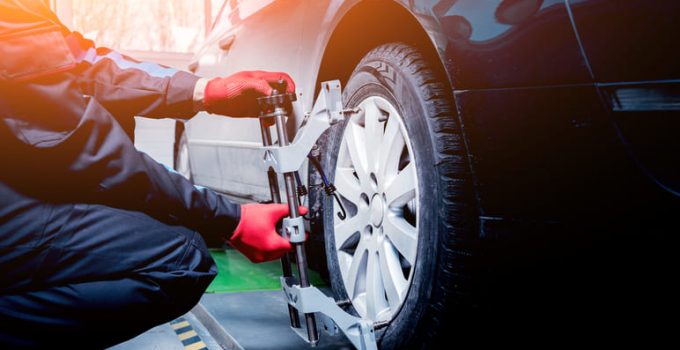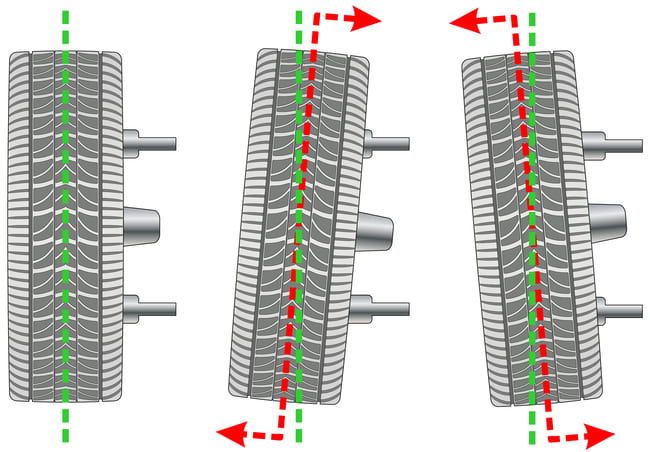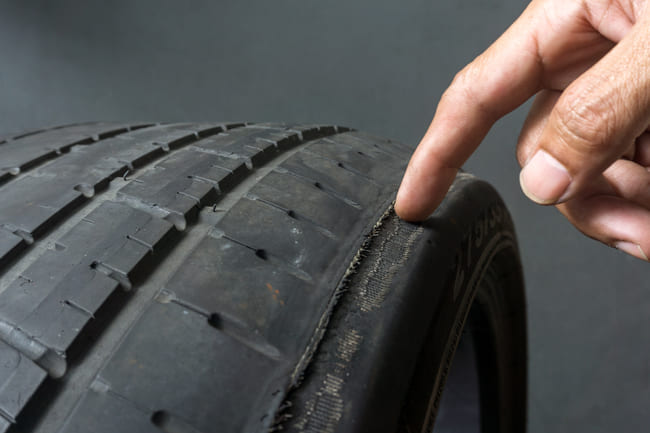
Basically, the wheel alignment and wheel alignment serves the optimal adjustment of your chassis. In this way we ensure that, for example, your tires wear out evenly and less severely. In addition, a correct wheel alignment of your car is also necessary to achieve the shortest possible braking distance. Of course, with such work, not only the current alignment of your chassis is determined, but also a toe and camber adjustment. In the following article you can find out how this works, whether you can lend a hand yourself or whether it is better to hire your trusted specialist workshop. If you don't yet have any knowledge of the structure of your wheel suspension, we recommend our Wheel Suspension article.
Contents
What is actually meant by toe-in and camber?

If one speaks of wheel alignment for a car, it is primarily about adjusting the toe and camber. But first of all, as a driver, you have to know what it actually means. If one speaks of the track of a car, it is about the so-called parallel running of your wheels or tires. These are viewed from above. The track plays an important role, especially when accelerating, braking and cornering. If this is not set correctly, your car tends to behave almost unpredictably. If the track of your car is neutral, then the corresponding tires are exactly parallel to each other. Such tracking is always important if you want to achieve maximum speed. However, this is rarely chosen in order to achieve the highest possible level of driving safety. For example, most cars are given a so-called toe-in during wheel alignment. This is always the case when the front of the wheels are a little closer together than the rear. Viewed from above, this looks a bit like a light plow when skiing. The opposite is a so-called toe-in. The advantage of a slight toe-in adjustment is that when braking heavily, the tires will either shift to a neutral position or toe-out. In the case of toe-out adjustment in particular, problems can arise when the driver controls the vehicle. This is because such a car easily oversteers, which can easily cause it to skid.
Camber, on the other hand, is about optimal tire tread grip when cornering. The alignment of the wheels from a position behind the vehicle is considered for the camber. If the camber is exactly neutral, this means that the outside of the wheel is exactly at a 90° angle to the road. The value for the is then exactly 0°. If the angle is larger (e.g. 95°), the negative camber is 5°. Then the corresponding wheel is tilted outwards at the bottom. The picture is reversed with a positive camber of 5°. Here the angle between the outside of the wheel and the road surface is only 85° and your bike is tilted inwards at the bottom. If you drive your car through a curve, the resulting lateral forces push the wheels inwards at the bottom, i.e. in the direction of a neutral or even positive camber. This is also the main reason why most street legal vehicles have a slightly negative camber as standard. Ultimately, this supports cornering grip. This is because the tire contact area increases automatically. Common values are -1° to -3°.
When is wheel alignment necessary and what are the costs?
The actual cost of having your car wheel aligned can vary widely. If it's just a simple measurement, you can usually do it with less than one hundred euros. If corrections have to be made afterwards and if these are not particularly complex, they are in the range of around 150 euros. All in all, you have to reckon with around one hour of work time.
But when do you even have to think about wheel alignment? There are some symptoms that can be caused by faulty axle geometry. This includes, for example, rumbling driving noises that can be localized in the area of your chassis. In addition, squeaking when cornering can also indicate such a problem. In addition, when replacing tires, look out for signs of uneven wear.

This not only applies to the tread of each individual tire, but also to the comparison of the two tires on one axle. A spongy steering and your car pulling (no matter whether to the right or left) also indicate defects in your chassis. Ultimately, of course, an wheel alignment must also be carried out after every repair and every change to the chassis.
How to carry out an wheel alignment
While mirrors and special light sources as well as mechanical mounts were mostly used in the past, computer-aided laser wheel alignment systems dominate today. This shortens the time for a measurement (without adjustment, correction and control) to about a quarter to half an hour. Such special tools for wheel alignment are necessary, among other things, because the multi-link axles that are built in today do not cope well with inaccuracies. If a laser-assisted system is used (this is the most common variant), appropriate sensors are mounted on each of the individual vehicle wheels. These can then evaluate the relative positions to each other and thus determine camber and toe accurately. Finally, if desired, the computer is not only able to process the measured values graphically, but also to compare them with the appropriate target values.

An alternative is the so-called 3D wheel alignment. Special reflectors including marking points are used for this. After a camera has taken a corresponding picture or several of them, this can be evaluated in order to get a good overview of your axis setting. If your wheel geometry deviates significantly from the target values in such a measurement, you can often have corrections made directly.
Carry out an axle measurement on the car yourself
You may be wondering if you can save money and do wheel alignment yourself. You should keep in mind that this work is now almost exclusively computer-aided. This allows a particularly high level of precision and thus always an optimal result. A wheel alignment device is used for this. In many cases, this is very expensive to purchase, so that it is hardly worthwhile for a one-off measurement. You may be able to find the right wheel alignment tool in a very well-equipped self-help workshop. However, always bear in mind that you could possibly be taking a safety risk if you make serious mistakes when correcting your wheel alignment or adjusting your wheel suspension. If you are primarily concerned with such work to fix a problem with a knocking suspension, we recommend our corresponding article on the subject.
Conclusion
When working on your chassis, you should always think about the correct setting of your chassis geometry. This can be precisely determined by wheel alignment and then corrected. In addition, the regular check does no harm, especially if you notice certain symptoms, such as uneven tire wear. The same applies after accidents, even if it is only supposed to be minor body damage.
A tip from CarTipsandmore: If you often drive on roads with potholes, especially at higher speeds, then we recommend A regular axle geometry check is often necessary. As a first step, you should make sure that your steering wheel is actually straight when you drive your vehicle straight ahead. You should take a closer look at every deviation, because a faulty axle geometry can not only be expensive, but also dangerous.
